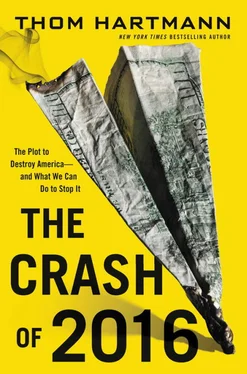Richard Wolff notes that during the 150-year period from 1820 until the 1970s, Americans saw a steadily rising standard of living. 171He notes that around the time of the Great Depression the average American family owed about one-third of their annual income in debt.
But by 2008, the average American family was in debt to the tune of 130 percent of their average annual income. These are debt levels never before seen in history, and the middle class now has nowhere else to go. They’re tapped out. They’re not going to start spending and, thus, “save” the economy the way they did in the middle of the twentieth century.
Credit card debt in America has reached over $860 billion. Student loan debt is at just under $1 trillion. Mortgage debt is at over $10 trillion. 172
But this is just the beginning. Wall Street can only make so much money through traditional lending, but through complex derivatives that banks can sell back and forth to one another, then an endless amount of profits, unlike any the world has seen before, can be made.
So Wall Street went nuts buying and selling derivatives to and from each other. That derivative market grew 1,000 percent since 1996.
Sensing that something bad is happening, Warren Buffett told Berkshire Hathaway shareholders, “The derivatives genie is now well out of the bottle, and these instruments will almost certainly multiply in variety and number until some event makes their toxicity clear… [They] are financial weapons of mass destruction, carrying dangers that while not latent, are potentially lethal.” 173
We learned the dangers of the derivatives market in 2008, when the world’s largest insurance corporation, AIG, failed because of bad bets on derivatives. Today, the derivatives market is even larger, and banks and sovereign economies have mind-bogglingly dangerous exposure to these derivatives.
Columnist Thomas Kostigen explains the scope of this problem in a 2009 MarketWatch article, writing, “Try as we might to salvage the residential real estate market, it’s at best worth $23 trillion in the U.S. We’re struggling to save the stock market, but that’s valued at less than $15 trillion. And we hope to keep the entire U.S. economy from collapsing, yet gross domestic product stands at $14.2 trillion.” 174
He adds, “Compare any of these to the derivatives market and you can easily see that we are just closing the windows as a tsunami crashes to shore.”
At $1.2 quadrillion, the derivatives market is roughly twenty-one times the size of the global GDP. To say that all the money in the world can’t stop the derivatives market from imploding wouldn’t be an exaggeration. In fact, it’d be a gross understatement.
The biggest American banks stand to lose the most as the derivatives market begins unwinding as a result of the economic shocks in Europe and China.
JPMorgan Chase, with total assets of just over $1.8 trillion, has more than $69 trillion exposed in derivatives.
Bank of America, with total assets of $1.4 trillion, is exposed to $44 trillion in derivatives.
And Goldman Sachs, with $114 billion in assets, is exposed to more than $41 trillion in derivatives.
Should the massive derivatives market get destabilized (as it appears the Royalists are preparing for), then there’s no amount of money that can prevent the coming crisis.
So with no other choice, the Royalists have to keep the scheme going at all costs. More than five years removed from the last burst of the housing bubble, it’s increasingly obvious that another housing bubble is being inflated with low-interest-rate money.
Major cities such as Los Angeles, New York, and Washington, DC, are seeing their real estate sectors boom once again despite the internal problems with the economy.
In April 2013, house-flipping in California reached its highest level since 2005, fueled by rapidly increasing real estate prices. In fact, median home prices in the Bay Area have returned to pre-2007–08 housing-crash levels. In San Francisco, the median home price is more than $1 million. 175
But this endless boom-bust cycle in real estate can sustain itself only for so long. Eventually the Crash of 2016 will spread from disaster zones such as Camden, New Jersey, and Flint, Michigan, to the centers of affluence in America.
When this starts to happen, there will be European-style runs on the banks in America. One by one, the major banking institutions in America will dissolve, taking with them the credit lines to businesses large and small. Companies won’t be able to meet their payrolls. There will be massive layoffs.
The American economy, the largest empire that has ever graced the planet, will collapse spectacularly in front of our eyes.
CHAPTER 12
Organized People v. Organized Money
It seemed but a few short days until more than fifty [tents] were set up, and then our troubles began. Business houses in the district did not know us. They considered us a bunch of ne’er-do-well undesirables and wanted to be rid of us… [H]ealth officials decided our shacks were unfit for human habitation and a menace to health conditions in the city, and posted official notices… informing us of the fact and giving us seven days in which to vacate them… [A]t the expiration of the seven-day notice, at 5 a.m., just as daylight was breaking, in one of the heaviest downpours… a regiment of uniformed officers of law and order swooped down upon us, with cans of kerosene and applied the torch.
—Jesse Jackson, Mayor of Seattle’s “Hooverville,” 1930
Jesse Jackson tried to find cover from the rain, but his makeshift home, cobbled together with scrap wood, canvas, and tin sheets, provided little cover. He waited with trepidation, knowing that as soon as the sun broke the horizon in the East, then all hell would break loose around him.
He was surrounded by several hundred others just like him, people who had come to the shores of Elliott Bay in Seattle, Washington, flanked by a steel-manufacturing plant, shipping crates, and the Seattle Transfer Company warehouse, to find a new start while the American economy went into a tailspin.
There were no jobs, no social safety net, and little charity to be found in the city, so the unemployed and desperate began occupying a nine-acre space of land in between the bay and a line of railroad tracks to the east, building shacks and tents for shelter and setting up a community to help one another survive.
But their occupation didn’t sit too well with nearby businesses. The “occupiers” were considered riffraff troublemakers and criminals. Health officials dropped by and decided the occupation was a health risk that threatened the city of Seattle. Soon, Jackson noticed official warnings posted around the various dwellings informing the occupiers that they had seven days to pack up and get out.
The notices were ignored, and on that seventh night, as their encampments were sinking into the mud in the relentless downpour, Jackson and the other occupiers waited for what might happen in the morning.
Then, just as they feared, at five o’clock in the morning, when the sun breached the railroad tracks, a cavalry of police officers swooped down upon Jackson and the others. Armed with cans of kerosene, they doused the makeshift city and applied the torch, thus putting an end to the occupation.
Just replace the kerosene and torches with less-lethal rubber bullets and pepper spray, and this sounds like a story from 2011, when the Occupy Movement flared up and began setting up tents in public parks all around the nation, from New York City to Chicago to Seattle. But it actually happened exactly eighty years earlier, when the nation was drowning in President Hoover’s Great Depression, and not President Bush’s Great Recession. These settlements weren’t called “occupations” at the time, they were called “Hoovervilles.”
Читать дальше












